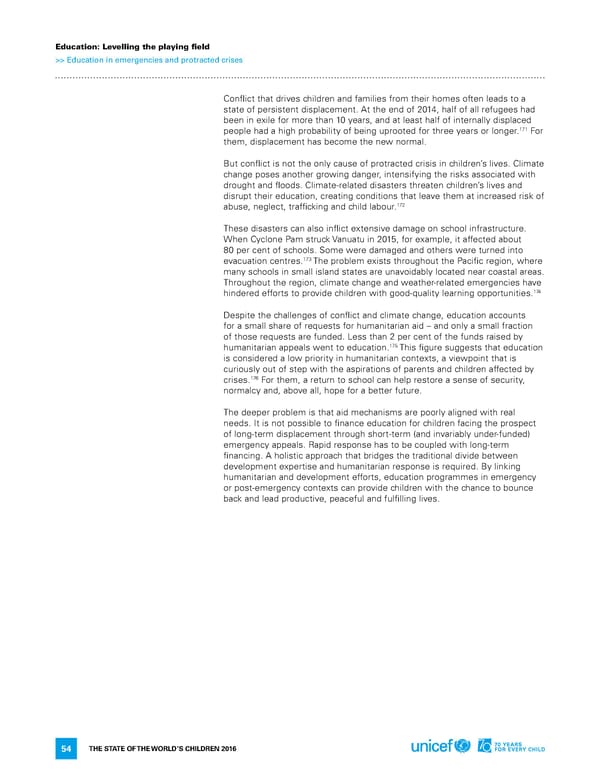Education: Levelling the playing field >> Education in emergencies and protracted crises Conflict that drives children and families from their homes often leads to a state of persistent displacement. at the end of 2014, half of all refugees had been in exile for more than 10 years, and at least half of internally displaced 171 people had a high probability of being uprooted for three years or longer. for them, displacement has become the new normal. But conflict is not the only cause of protracted crisis in children’s lives. Climate change poses another growing danger, intensifying the risks associated with drought and floods. Climate-related disasters threaten children’s lives and disrupt their education, creating conditions that leave them at increased risk of 172 abuse, neglect, trafficking and child labour. These disasters can also inflict extensive damage on school infrastructure. When Cyclone Pam struck Vanuatu in 2015, for example, it affected about 80 per cent of schools. Some were damaged and others were turned into evacuation centres.173 The problem exists throughout the Pacific region, where many schools in small island states are unavoidably located near coastal areas. Throughout the region, climate change and weather-related emergencies have hindered efforts to provide children with good-quality learning opportunities.174 despite the challenges of conflict and climate change, education accounts for a small share of requests for humanitarian aid – and only a small fraction of those requests are funded. less than 2 per cent of the funds raised by 175 humanitarian appeals went to education. This figure suggests that education is considered a low priority in humanitarian contexts, a viewpoint that is curiously out of step with the aspirations of parents and children affected by 176 crises. for them, a return to school can help restore a sense of security, normalcy and, above all, hope for a better future. The deeper problem is that aid mechanisms are poorly aligned with real needs. it is not possible to finance education for children facing the prospect of long-term displacement through short-term (and invariably under-funded) emergency appeals. rapid response has to be coupled with long-term financing. a holistic approach that bridges the traditional divide between development expertise and humanitarian response is required. By linking humanitarian and development efforts, education programmes in emergency or post-emergency contexts can provide children with the chance to bounce back and lead productive, peaceful and fulfilling lives. The STaTe of The World’S Children 2016 54
 70 Years for Every Child Page 69 Page 71
70 Years for Every Child Page 69 Page 71